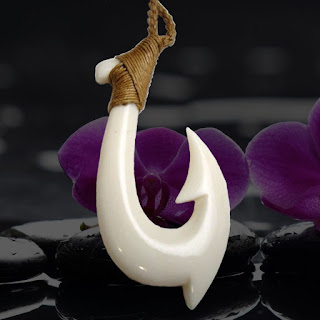The origins of the fish hook
 |
| Pacific Fish Hook Necklace |
caught by the great mariner Maui using only a woven line and a hook made from the jawbone of his grandmother. Legend suggests that the shape of Hawke Bay is that of the hei matau, which caught in the fish's side on the beach. The Māori name for the North island, Te Ika a Maui ("The fish of Maui") reflects this myth.
For the Māori, the Hei Matau is taonga (a cultural treasure). It characterizes not only their land, but also prosperity, fertility and safe passage over water. They also denote the importance of fishing to the Māori, and their relationship to Tangaroa god of the sea.
The meaning of the fish hook to the Hawaiian culture
To the Hawaiian the meaning of the fish hook pendant came from the extraordinary respect Hawaiians have had for the ocean, which has provided sustenance and enabled travel. Hawaiian Life details the history of the Macau, as this pendant is called in Hawaii. Initially, the Macau was put to practical use in fishing. It is now frequently worn around the neck for its symbolic power and perceived benefits.Fish hooks were used by island men and women to catch and gut fish, as well as catching and preparing other types of food. The main function for fish hooks today is to wish someone a successful future or good health. They are also used, of course, simply for adornment.
The symbolism and value the fish hook presents spread all over the Pacific Ocean cultures.
The fish hook to the Tongan Islands
In the old times, Maui obtained a fish hook from an old fisherman named Tongafusifonua. Plausibly, Maui went fishing. He dropped the fish hook into the ocean, but when he tries to pull up the line, it seems to be caught upon something. Maui pulled and pulled until the hook appeared once more, but with it also comes an island! Well, Maui kept throwing the hook into the water until the main islands of Tongatapu, Ha’apai and Vava’u are all pulled from the ocean. (Eua and some of the smaller volcanic islands were created separately by the god craftsman Tangaloa whose wood shavings fell from the sky.)At any rate, Maui names the largest island “Tonga” in honor of the old fisherman, and that island is now Tongatapu, with the capital city Nuku’alofa. But the demi God Maui isn’t done fishing yet! Pleased with his success, Maui kept fishing, eventually pulling up most of the islands of Tonga, as well as — depending upon the legend source — some of the islands in Hawaii, Samoa and Fiji.
The fish hook symbolism to the Samoan Islands
 |
| Fish hook Engraved of Koa Wood |
The fish hook necklace today
Before Pacific Islanders would make fish hooks of fish bone, cow bone and from all sorts of material from the ocean. Today, with the increased demand on the fish hook necklaces, especially with in cultures of the surf, the hip, the multi-cultured, the believers of luckism, the collectors or as featured in Disney's 2016 movie Moana with the demi God Maui and his magical fish hook; within the increased popularity of fish hooks in the mainstream, fish hook necklaces are now available in both hand carved or mass produced of large assortment of materials such as gold, silver, stainless steel, jade, wood, bone, resin & horn. Fish hook necklaces are not practical for fishing and yet they make pretty cool accessory.Wither you are a luckism believer or not, the fish hook remains a largely known symbol of beauty, strength, prosperity, fertility, safe travels & happy fishing; or just a cool what is that kind of necklace.
Foot note
The Hawaiian fish hook necklace is known in many of the Pacific rim cultures by many phrases. The following are just some:- Fish hook necklace
- Hawaiian bone fish hook
- Hawaiian fish hook necklace
- Hawaiian hook necklace
- Hei Matau
- Hook necklace
- Koa wood fish hook necklace
- Magical fish hook necklace
- Maori bone fish hook
- Maori fish hook
- Maori fish hook necklace
- Maori hook
- Maori hook necklace
- Maui fish hook necklace
- Maui hook necklace
- Maui hook necklace
- Men fish hook necklace
- Men fish hook necklace
- Men hook necklace
- Pacific fish hook necklace
- Polynesian fish hook necklace
- Samoan fish hook necklace
- Surfer fish hook necklace
- Surfer necklace
- Surfer dude necklace
- Tahitian fish hook necklace
Nice!
ReplyDeleteIt is a great symbol of courage and bringing food into the house. I gave something like this to my father when I picked out his jewelry on the website https://www.bikerringshop.com , now these ornaments are very popular for surfers or bikers.
ReplyDelete
ReplyDeleteVery well displayed. Thanks for the post. It was very interesting.
Jewelry Editing Services
Looks like this is the necklace in the Movie Moana
ReplyDeletefish necklace meaning
I'm from Hawaii as well as family members going back 200 years or more.I love what the hook represents and it means a lot. Thanks
ReplyDeleteDiscover the beauty of Lab grown emerald gemstone, crafted with precision to offer the same stunning brilliance as natural emeralds. Shop high-quality, eco-friendly, and affordable emerald gemstones for your jewelry collection.
ReplyDelete